An Increase in Sedimentation Along a Stream Can Be Caused by
Introduction
Streams accept a major role in geology. Streams sculpt and shape the earth'southward surface past eroding, transporting, and depositing sediment. By eroding sediment from uplifted areas and creating landforms made of deposited sediment in lower areas, streams shape the earth's surface more than glaciers do, more than than waves on a beach exercise, and far more than than wind does.
What Are Streams?
A stream is flow of h2o, driven by gravity, in a natural channel, on country. A small brook in a meadow and the Amazon River are both streams. It is interesting to watch water on a recently bulldozed construction site with a slope. At first the water saturates the basis and begins to period downhill beyond the surface of the slope in a sparse canvas. Shortly, the h2o excavates small channels, known as rills, in the dirt. Rills coalesce to form larger channels. A network of streams, including tributaries, has formed. If not prevented, the channels may continue to deepen and erode soil from the structure site.
Over longer intervals of time the aforementioned processes we've imagined on the construction site take built systems of streams and stream valleys on the surface of the world. Most valleys on earth are the product of streams. Streams erode dirt and rocks, transport the sediment, and redeposit information technology in new locations, shaping the earth's surface into a system of stream valleys.
Streams catamenia downhill due to the force of gravity. The higher the hill, the more gravitational free energy there is to drive the stream. Where the slopes are steepest and the hills the highest, the streams will be the most energetic and the rate of erosion will be fastest.
Drainage Surface area
The drainage area of a stream encompasses all the land from which surface runoff flows into that stream. A stream drainage surface area is too called a watershed. Boundaries between stream drainage areas are called drainage divides. What stream drainage do you alive in?
Stream Lodge
It is common for one stream to flow into another. The smaller of the 2 streams is a tributary of the larger stream. A stream with no tributaries is a first order stream. A stream with only get-go-order tributaries is a second order stream. A stream that has any second-social club tributaries and none higher is a third-order stream, and so on. The Mississippi River is a tenth club stream, 1 of the highest gild streams on earth. Equally more than and more than tributaries join together a larger stream network is formed and the main stream, the highest club stream in the system has a belch that is the sum of all the tributary discharges. When flooding occurs, college order streams take longer to build up to flood stage than lower club streams and longer for the flood to subside.
Drainage Patterns
A stream arrangement that includes multiple tributaries exhibits a distinct drainage design every bit seen on a map. The drainage blueprint depends on the rock types and geologic structures underlying the stream system. Some types of rock are harder and more resistant to erosion than others. If the geology underlying a stream system is fairly uniform—rocks equally resistant to erosion in all directions—a dendritic drainage design will develop, as shown in figure 1. A dendritic drainage blueprint is the most common type.
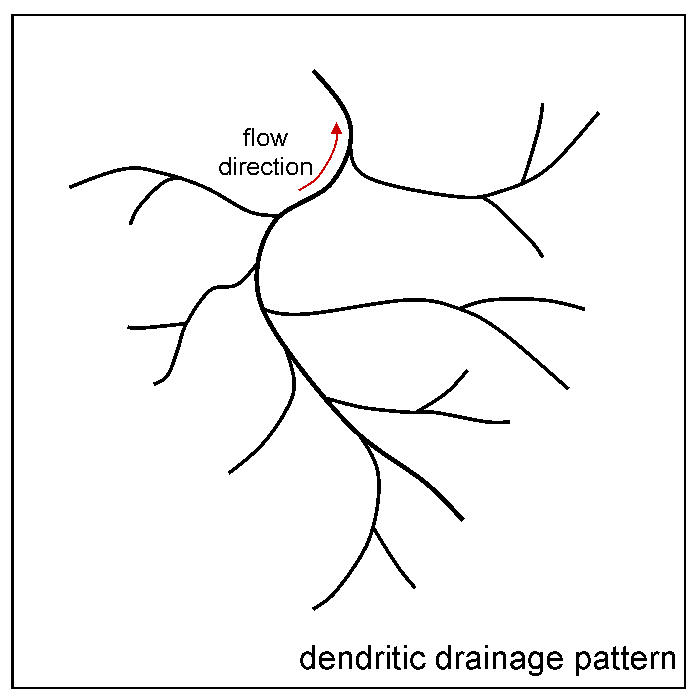
Figure i
If a region is underlain by layered formations of rock that have been folded, and the layers have different degrees of resistance to erosion, the stream valleys will tend to follow the layers of less resistant rock, and the layers of harder stone will become ridges. This results in a trellis drainage blueprint, every bit testify in figure two.
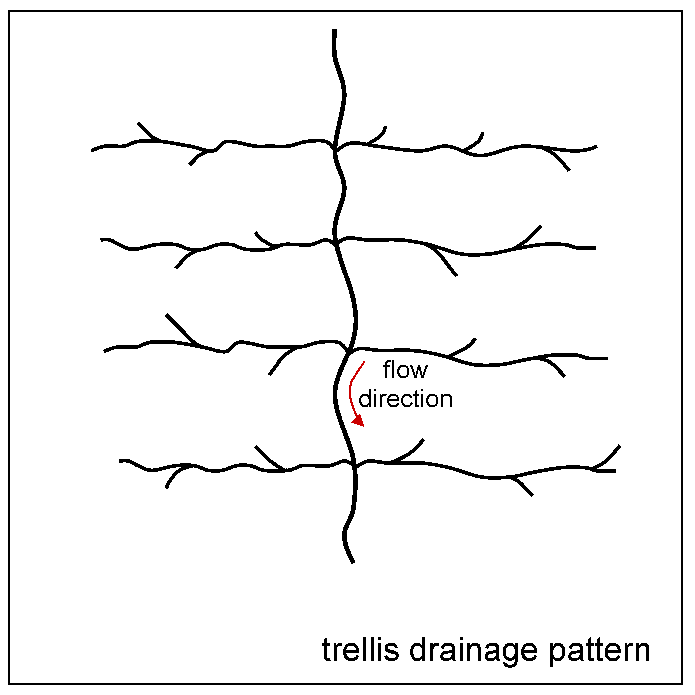
Figure 2.
In some places the geology consists of a single type of rock that is resistant to erosion simply the rock contains sets of parallel joints where it erodes more easily. The sets of joints typically intersect each other at high angles. As stream valleys develop in the joint organisation a rectangular drainage blueprint develops, equally shown in figure iii. The stream valleys volition bend sharply where they switch from following i articulation set to another.
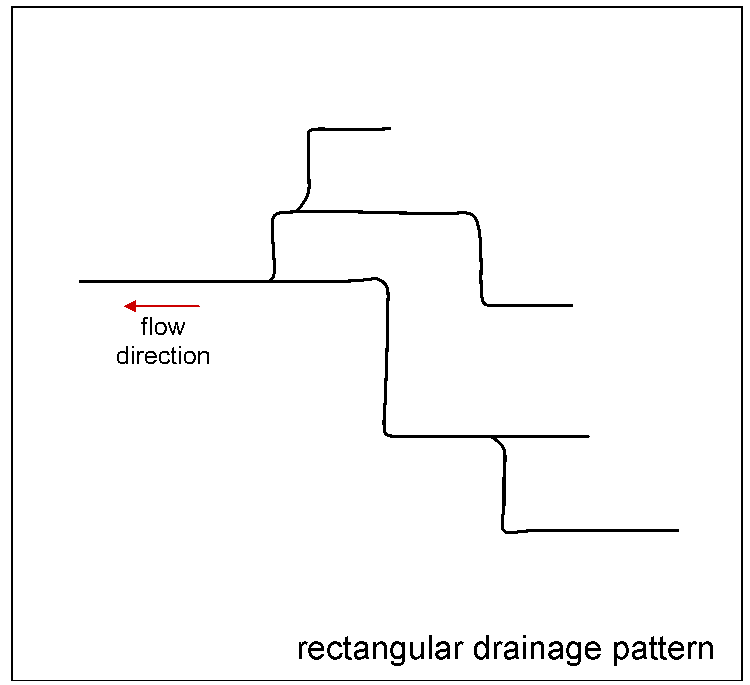
Figure iii.
Streams will radiate in all directions from the centre of a broad, loftier-summit area, such as a blended cone. This is known as a radial drainage pattern.
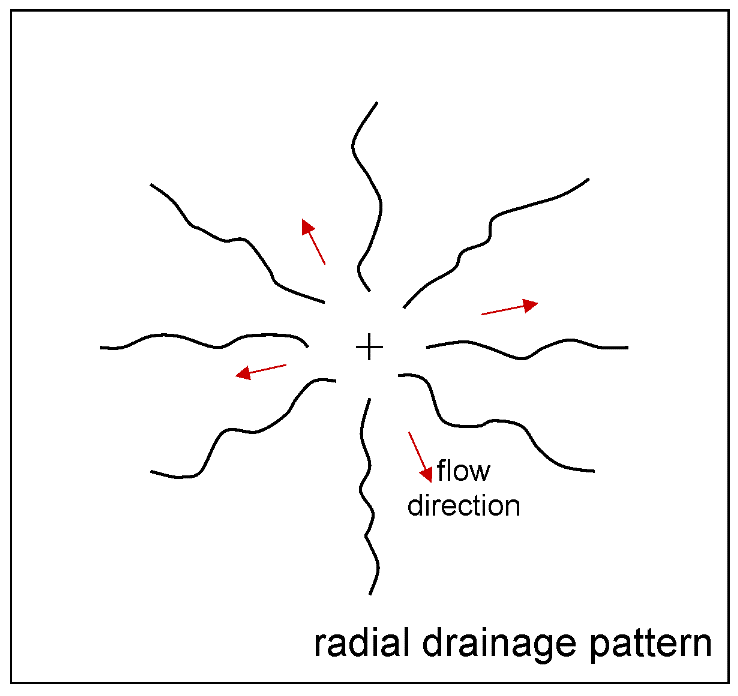
Figure four.
Graded Profile
Considering streams erode more and remove more sediment where the stream gradient is higher, and deposit more sediment where the stream slope is lower, a stream volition develop a graded profile equally shown. The graded contour shows how the elevation of the stream changes along the length of the stream, from its beginning at the highest height to its base level where it ends at the lowest meridian it reaches.
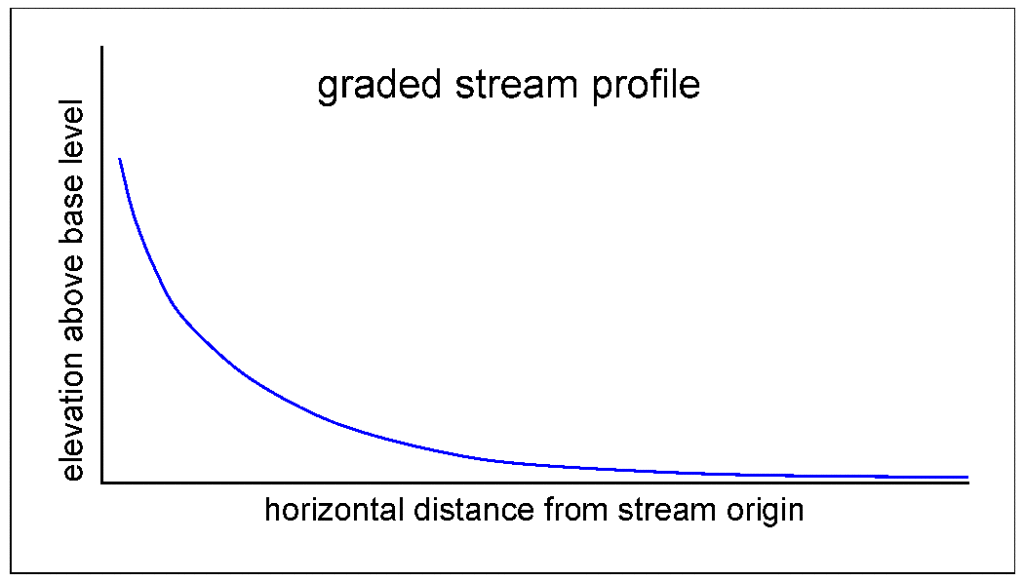
Figure 5.
A graded profile starts with a steep slope at the beginning of the stream and tapers to a gentle slope at the base of operations level of the stream. Imagine a hiker following a stream up to its showtime and tracking her progress on a topographic map. She starts out where the stream valley is depression and wide and the gradient is gentle so the hiking is easy. Equally the twenty-four hours goes on, the going gets steeper as she approaches the stream source. Checking the topographic map, she sees that the contour lines are much closer together than they were earlier in the day and further downwards the valley. As she approaches the minor lake on the side of the mountain where the stream begins, the gradient is and so steep that most loses her footing. She has experienced for herself a typical stream profile that steepens from well-nigh the base of operations-level to the origin of the stream.
Lakes and waterfalls are temporary features in a stream drainage. If a lake forms the stream feeding it will tiresome downwards and deposit sediment until the lake has been filled with sediment. Where a waterfall forms the free energy of the stream going over the waterfall is loftier volition erode the base of the waterfall, causing the waterfall to retreat upstream until a graded profile is established.
Stream Discharge
The amount of water flowing through a stream and speed at which it is moving is expressed as the discharge of the stream. Discharge is measured by multiplying the cantankerous-sectional expanse of a stream by the boilerplate speed of water through that cross-department. Multiplying the expanse of the cross-section by the average speed of the water results in units of book/fourth dimension. For example, if a stream has a cross-sectional area of 150 square feet (ft2) and is moving at an average speed of 10 feet per 2nd (ft/s), multiplying the area and the speed results in a discharge of 1,500 cubic feet per second (ftiii/south).
Sediment Load
The h2o flowing in streams erodes, transports, and deposits sediment. Almost rocks and minerals are much denser than water. Sufficient energy in the stream is required to dislodge rocks from the earth and movement them. The faster a stream flows, the more energy it has and the larger pieces of sediment it can ship. The competence of a stream refers to the maximum size of the pieces of sediment it can move. Faster-moving water has greater competence and can move larger pieces of sediment.
The capacity of a stream is the full corporeality of sediment it can motion. Capacity depends on how fast the stream is moving and its total discharge. Equally a stream slows down, its competence and capacity are reduced. The stream starts to deposit sediment, beginning with the largest pieces. Several factors crusade a stream to boring downwardly, including the stream channel widening, the stream overflowing its banks and spreading into a floodplain, the stream slope (downhill slope) diminishing, and the stream emptying into a larger, slower moving body of h2o.
Streams transport clastic sediment in 2 ways depending on the size of the particles. The coarser sediment is chosen bed load and consists of particles too large to be suspended in the moving current of h2o for an extended length of time. The bed load particles, the largest particles of sediment transported past a stream, spend most of their time on the bottom of the stream channel, rolling, sliding, or bouncing downstream in fits and starts. The finer sediment is called suspended load and consists of particles small plenty to be suspended in the moving electric current of water. Suspended load moves at about the aforementioned rate as the flowing water. In a muddy river, the mud is suspended load
Floodplains
Streams build floodplains through a combination of erosion and deposition at lower gradient stretches of stream valleys. Although a floodplain has a general downhill slope consequent with the overall stream gradient, a floodplain is relatively flat.
Floodplains are filled with sediments spread by the stream. These sediments are known equally alluvium. Because alluvium is loose material that is easy for the stream to erode and redeposit, the location of a stream channel in a floodplain changes often.
Meanders
A stream running downwards a gradient, fifty-fifty the gentle slope of a floodplain, will seldom follow a straight path for very long. Depending on the distribution of sediments and turbulence of the stream, one side of the channel may erode more hands than the other. The stream will drift toward the surface area undergoing erosion, developing a curve in that direction. Once the stream channel has begun to bend, the energy of the water is concentrated on the outside of the curve.
The diagram shows a stretch of stream channel with a significant bend, also known as meander. The blueish line shows how erosive free energy is concentrated along the outside of each curve in the stream. Equally erosion occurs on the outside depository financial institution of a meander, deposition occurs on the inside banking company where the water slows and drops sediment.
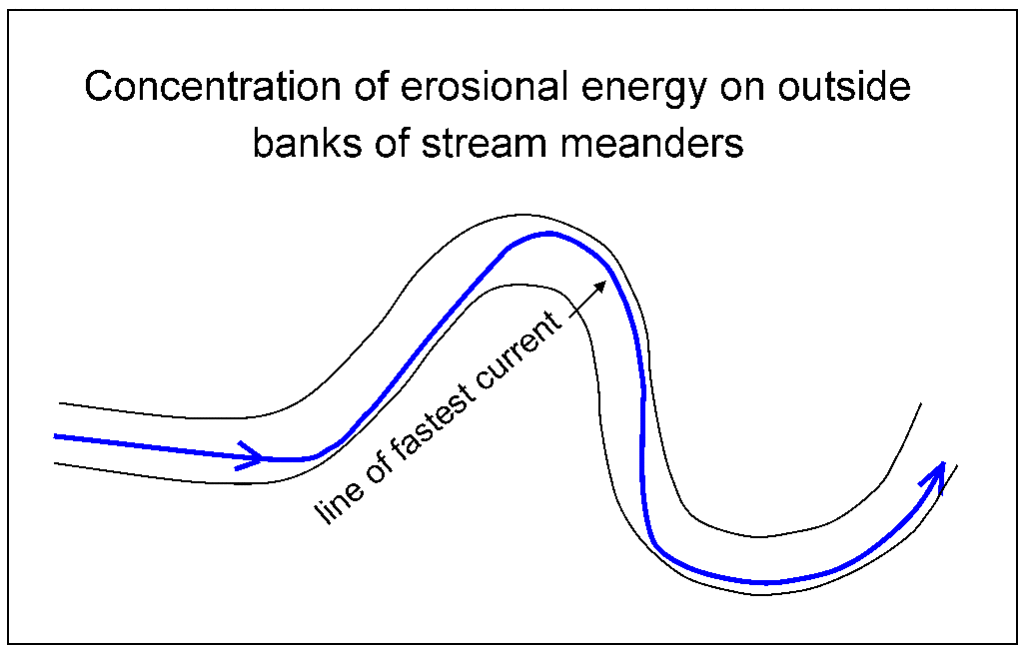
Figure 6.
The diagram below shows two well-developed meanders that have formed in a stream. Along each meander, the outer stream bank that is existence cutting into by erosion is called a cut bank. The inner bank, which has grown by accretion of deposited sediment, is called a point bar.
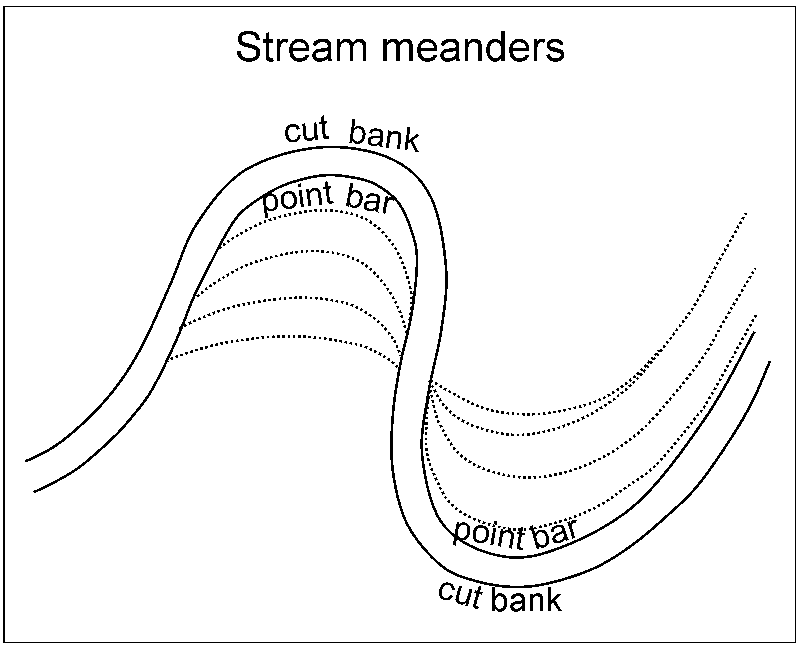
Figure 7.
In a stream, meanders enlarge and drift downstream considering the stream continually erodes its cut banks and grows its indicate bars. The diagram below shows the enlargement and downstream migration of a meander in a stream channel. As the meander is enlarged, its neck gets narrower. Eventually, the stream may cut through the neck of the meander, either every bit a event of gradual erosion and channel migration, or abruptly during high h2o and flooding. Once the stream has cutting through the neck of the meander, the openings get filled with sediment dropped by water that slows downward as information technology enters from the master stream. The sediment deposits will separate the cut off meander from the river aqueduct and plow it into an oxbow lake. As the years get by, the oxbow lake will eventually be completely filled in with sediment considering it is a low spot on the floodplain where whatever h2o that enters, such as during flooding, will come to a standstill and eolith its sediment load.

Figure eight.
Entrenched Meanders
Typical meandering stream channels menstruation through broad flood plains full of alluvial sediment. However, in some situations meanders may cut directly into bedrock. A meander that has cut into bedrock is known as an incised or entrenched meander. In contrast to meanders in alluvium that erode and migrate rapidly or go cut off at the neck abruptly, entrenched meanders are relatively fixed. This is considering entrenched meanders are walled in by bedrock on both sides and have little floodplain to hands erode and redeposit.
Entrenched meanders course equally a effect of tectonic uplift of the stream drainage area. The uplift increases the gravity-driven energy of the stream causing information technology to incise rapidly down through the flood plain alluvium into the bedrock beneath. Entrenched meanders are striking landscape features because they are unusual and they provide potent testify of tectonic action in a region. Classic examples of entrenched meanders include the Goosenecks of the San Juan River, which are incised in the Colorado Plateau east of the Thou Canyon, and a stretch of the Yakima River with entrenched meanders, which are incised in a recently uplifted ridge of basalt in the Columbia Plateau of eastern Washington state.
Braided Streams
Rather than a single channel, some streams have multiple channels that weave in and out of each other forming what is known as a braided stream. Braided streams are associated with excessive amounts of sediment entering a stream system. Valleys draining alpine glaciers are common settings for braided streams. The glaciers deposit more sediment into the meltwater stream system than a stream of that discharge has capacity to transport in a unmarried channel organisation. Braided stream systems are indicators that there is an boosted source of sediment in the organization besides the stream itself. Sources of excess sediment that lead to braided streams include glaciers, eruptions of pyroclastic material by volcanoes and landslides.
Flooding and Alluvion Frequency
Streams flood. Flooding is a normal function of stream beliefs. The rate at which streams erode, ship, and deposit sediments profoundly increases during flooding. A flood occurs when the h2o depth in a stream exceeds the depth of the stream channel and spreads beyond the stream channel onto the surrounding country. When a stream completely fills its channel information technology is said to be at bankfull stage. When a stream surpasses bankfull stage it is said to be in flood. When the overflowing spreads widely enough to cause property damage, a stream is said to be at flood phase.
Different streams have different flood behaviors. Some rivers tend to have an annual inundation associated with a rainy flavour or snowmelt flavour in the higher function of the drainage expanse. Some streams only flood sporadically, often with years betwixt floods. In the The states all the larger streams accept their flow measured at gaging stations that are installed and monitored by the US Geological Survey. Records of stream period must be kept for at least 30 years to be statistically valid. The likelihood of a alluvion of a specified magnitude occurring on a stream in a given yr tin exist calculated from the stream flow data. The magnitude of a flood that has a ane out of 100 hazard of happening in a given year—besides known every bit the 100-yr flood—is calculated for a stream from it tape of stream period. The 100-yr flood magnitude, and maps that show what would be covered by a 100-year alluvion, are primal elements in granting permits for state use and building structure in floodplains.
Low order streams may flood apace during or immediately after heavy rainfall. Such rapid floods are called flash floods. Wink floods are oftentimes unpredictable. If a river drains through a canyon from a loftier pinnacle area, people may be walking forth a stream in the coulee in the sunshine and not realize that a thunderstorm is occurring at the stream'southward source. They may exist surprised by a flash flood sweeping through the coulee. A slow building flood on a higher club stream can usually be predicted because major streams are monitored and it takes longer for h2o from heavy rainfall or rapidly melting snow to move through the higher social club stream organization. Floods on the highest order streams, such as the Mississippi River, may accept several weeks to crest and subside.
Changes to the land in the drainage area of a stream, such every bit the addition of buildings and roads, can alter how a stream floods. Buildings and pavement that encompass the ground prevent infiltration and cause increased surface run off. Increased stream runoff ways smaller amount of pelting will cause the stream to achieve flood stage than before the alterations to the land. The stream will overflowing more than oftentimes. For the same amount and rate of rainfall that caused flooding prior to edifice, the stream will reach flood phase quicker and the alluvion will be deeper. The diagram below shows the flood response of a stream to a given amount of rainfall before and after the stream drainage area was urbanized past removal of wood and addition of buildings and roads. After urbanization, the stream reaches its acme inundation level quicker and rises to a higher level than before urbanization. Unless countermeasures are engineered and installed, an urbanized area will flood more ofttimes and severely than the aforementioned surface area when it was forested.

Figure 9.
Alluvial Fans
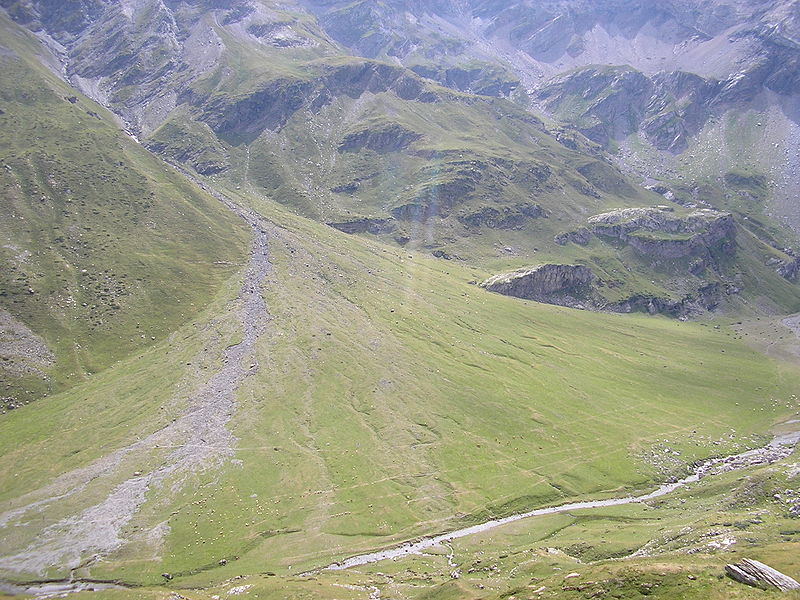
Effigy 10.
At the location where a stream reaches its base level, it slows down and deposits virtually all of the sediment it is conveying. A stream that comes downwards a canyon and enters a flat valley or plain builds a fan shaped deposit of sediment known every bit an alluvial fan. Alluvial fans are congenital mostly during flash floods. Alluvial fans are easy to recognize in arid areas only they form in wetter climates as well.
The diagram in effigy 11 shows in cross-section how an alluvial fan develops over time as sediment is eroded from higher elevation and deposited on the adjacent lower tiptop patently.
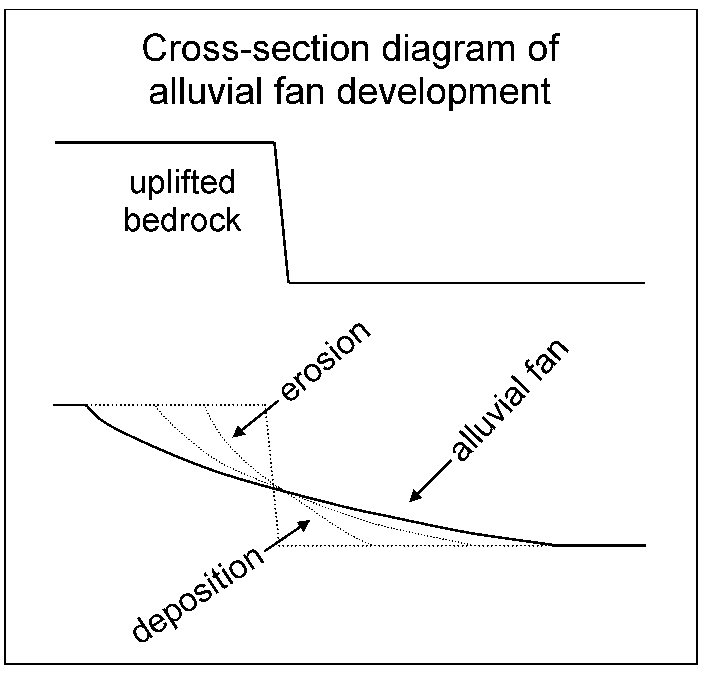
Effigy 11.
Deltas
Deltas are of import landforms to civilization. They provide fertile soils, apartment land, and water for agriculture, too as river channels for transportation.
A delta is a landform equanimous of sediment deposited where a stream enters a larger, slower moving body of water, such as an sea, a lake, or a larger river. The term delta comes from the triangular shape of the Greek letter delta (Δ). Ancient Greek geographers recognized the triangular shape of the land created by the Nile River where it emptied into the Mediterranean Sea and gave the name delta to that landform. The Nile River delta is one of several types of deltas that are defined past the predominate processes that shape them. The Nile delta is a moving ridge-dominated delta. Waves of the Mediterranean Sea have pushed and distributed sediment forth the coast, flattening the seaward side of delta.
The Mississippi River delta is an case of a stream dominated delta. Deposition of sediments has congenital the delta into the Gulf of Mexico faster than waves or tides could redistribute the sediment. As commonly occurs in a delta, the Mississippi River splits in the downstream management into several branches that discharge beyond the delta into the Gulf of Mexico. These branches are known equally distributaries. The mouth of each distributary has built part of the delta further out into the Gulf of Mexico forming what is known as a bird's foot delta, some other name for a stream dominated delta based on the way it looks on a map.
The Ganges River delta is a tide dominated delta formed from sediment eroded from the Himalaya Mountains, the largest mount range in the world. The mouth of the Ganges River is at the northern end of the Bay of Bengal, a large embayment of the Indian Sea. The shape of this large bay has a magnifying effect on the tides. The combination of stiff tides and the consistently high belch from a river caring a large sediment load create a branching pattern of distributaries, in effect a braided stream system across the delta.
Deltas are lowlands that lie barely above sea level and are at high take a chance of being submerged under water. There are several ways in which deltas tin be inundated by ascension water. Floods coming downwardly the river can comprehend a delta. Marine deltas tin be subject area to storm surges when extreme winds raise sea level along the coast and push ocean water inland. In the last several decades a new risk of submergence has arisen for marine deltas. Many marine deltas are undergoing gradual submergence as global bounding main level rises.
Reflection Questions
- What skill does this content help you develop?
- What are the fundamental topics covered in this content?
- How can the content in this department aid you demonstrate mastery of a specific skill?
- What questions practice you accept about this content?
Source: https://courses.lumenlearning.com/geology/chapter/reading-streams/
0 Response to "An Increase in Sedimentation Along a Stream Can Be Caused by"
Post a Comment